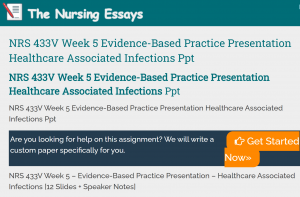Background
Hospitalization for an acute illness, trauma, chronic care, or other health care conditions is a common occurrence. There were 39.2 million hospital discharges in 2005, with an average length of stay of 4.6 days.1 Hospitalization brings associated risks, including risk of infection. Nosocomial infections, or hospital-associated infections, are estimated to occur in 5 percent of all acute care hospitalizations, or 2 million cases per year.2 Hospital-associated infections have been identified as one of the most serious patient safety issues in health care.3NRS 433V Week 5 Evidence-Based Practice Presentation Healthcare Associated Infections Ppt
Infections that become clinically evident after 48 hours of hospitalization are considered hospital-associated.2 Risks factors for hospital-associated infections are generally categorized into three areas: iatrogenic, organizational, or patient-related. Iatrogenic risk factors include invasive procedures (e.g., intubation, indwelling vascular lines, urine catheterization) and antibiotic use and prophylaxis. Organizational risk factors include such things as contaminated air-conditioning systems, contaminated water systems, staffing (e.g., nurse-to-patient ratio), and physical layout of the facility (e.g., open beds close together). Examples of patient-related risk factors include severity of illness, immunosuppression, and length of stay.2
Nosocomial infections more than double the mortality and morbidity risk for hospitalized patients, resulting in an estimated 20,000 deaths a year.2 Nosocomial infections increase the costs of hospitalization in addition to increasing morbidity and mortality risk. A meta-analysis of 55 studies examining nosocomial infections and infection control interventions determined that attributable costs are significant; costs associated with bloodstream infections (mean = $38,703) and methicillin-resistant Staphylococcus aureus infections (mean = $35,367) are the largest.3
Most infections in hospitalized patients are endogenous, meaning they are caused by bacteria that have already colonized the patient’s digestive tract prior to infection.4 The majority (60 percent) of infections in patients hospitalized in an intensive care unit (ICU) setting are caused by bacteria already colonizing the patient on admission (primary endogenous). A lesser amount (23 percent) of infections result from bacteria acquired during the ICU stay, leading to colonization before infection (secondary endogenous). A total of seventeen percent of infections are caused by bacteria introduced from the ICU environment that lead to infection without prior colonization (exogenous). Targeting hospital-associated infections is, therefore, a very important aspect of providing quality health care. NRS 433V Week 5 Evidence-Based Practice Presentation Healthcare Associated Infections Ppt
This chapter reviews the evidence-based knowledge on health care–associated infections, highlighting important information for nurses caring for hospitalized patients. The review focuses on hospital-associated pneumonia, urinary tract infection, catheter-related bloodstream infection, sepsis, and antibiotic-resistant infection. An evaluation of the literature, including recent research, and evidence-based practices are presented. NRS 433V Week 5 Evidence-Based Practice Presentation Healthcare Associated Infections Ppt
Hospital-Associated Pneumonia
Pneumonia is the second most common hospital-associated infection (after urinary tract infection).5 In critically ill patients, ventilator-associated pneumonia (VAP) is the most common nosocomial infection. VAP doubles the risk of death, significantly increases ICU length of stay, and adds more than $10,000 to each affected patient’s hospital costs.6
The current evidence-based recommendations by the Centers for Disease Control and Prevention (CDC) for prevention of nosocomial pneumonia were published in 2004.5 Although some of the interventions to reduce nosocomial pneumonia are the responsibility of physicians or other health care workers, many of the interventions are the direct responsibility of nurses or can be influenced by nurses. Nursing care can directly contribute to prevention of hospital-associated pneumonia, particularly in patients who are most at risk due to advanced age, postoperative status, or mechanical ventilation. The evidence shows that the most important contributions of nursing care to prevention of hospital-associated pneumonia are in four areas: hand hygiene, respiratory care, patient positioning, and education of staff. NRS 433V Week 5 Evidence-Based Practice Presentation Healthcare Associated Infections Ppt
Hand Hygiene
